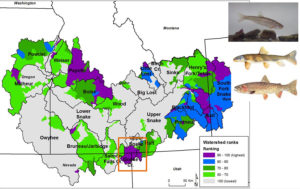
Efficient conservation can require making strategic decisions across large landscapes. For example, two Fish Habitat Partnerships – Desert Fish Habitat Partnership (DFHP) and Western Native Trout Initiative – fund conservation and restoration projects across western United States. DFHP alone serves 11 states and nearly 180 native fish species. Because they serve large landscapes, the partnerships are using multispecies aquatic assessments developed for specific river basins to make conservation delivery more efficient. These assessments yield a conservation value for every catchment in a basin based on known and modeled native fish distributions (including salmonids), riverine connectivity, and threats to aquatic habitats. The conservation values are scaled between 0 (low) and 1 (high) and have been used as one of several criteria to evaluate conservation projects submitted for funding through the National Fish Habitat Partnership. While assessments are complete for some basins (e.g., Upper and Lower Colorado Basins), the partnerships are currently working with additional partners, such as the Southern Rockies Landscape Conservation Cooperative, to fund additional aquatic assessments in new geographies (e.g. Rio Grande Basin). Using multispecies assessments to inform on-the-ground conservation across large landscapes makes conservation delivery more efficient for the many imperiled native fishes in the western United States.
